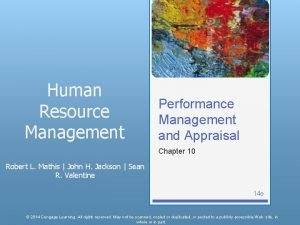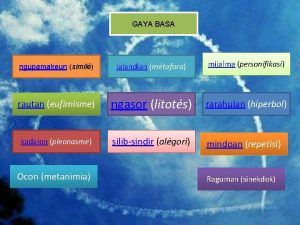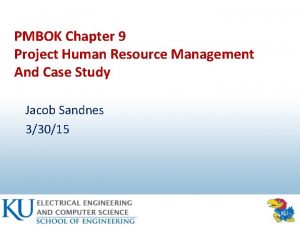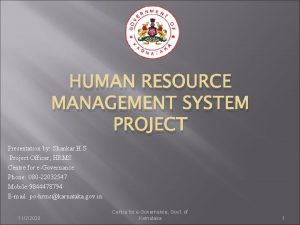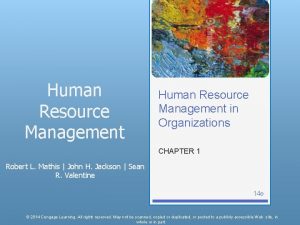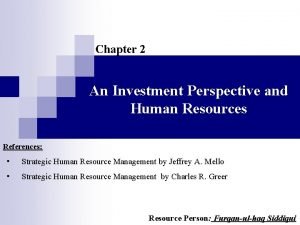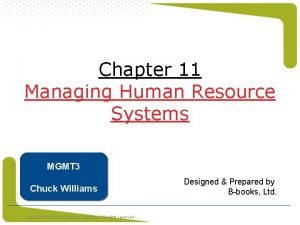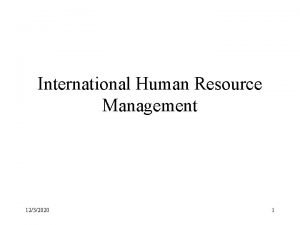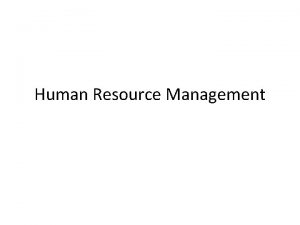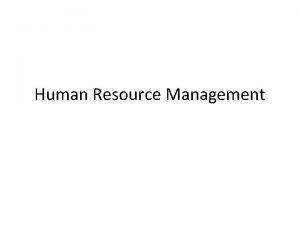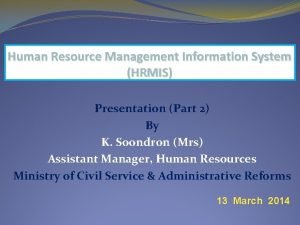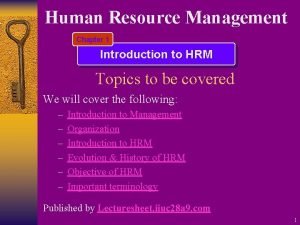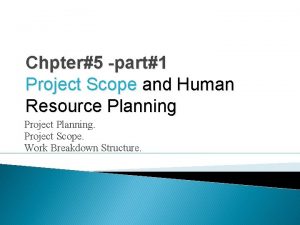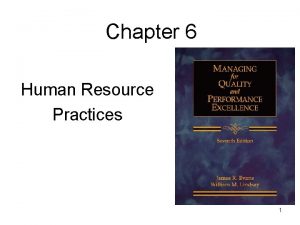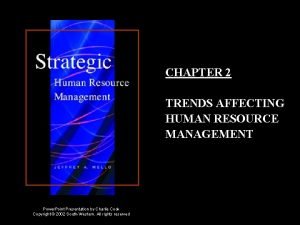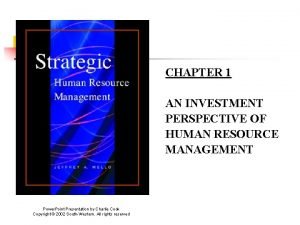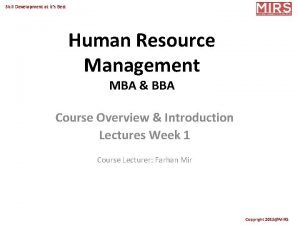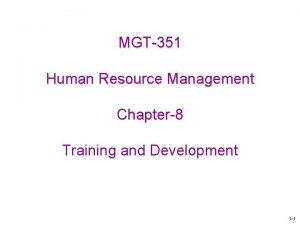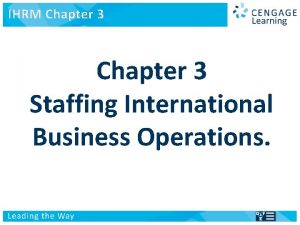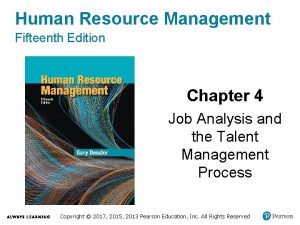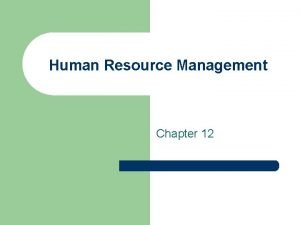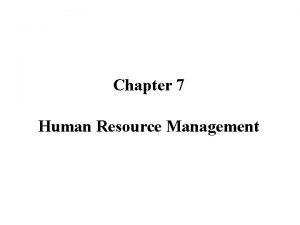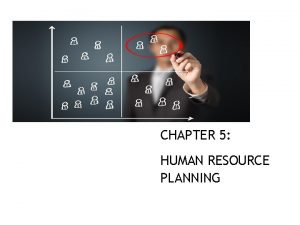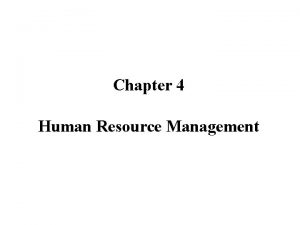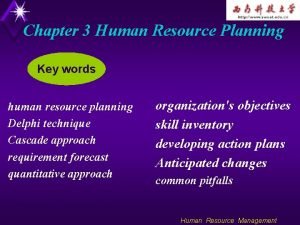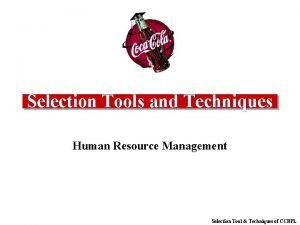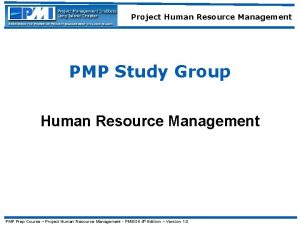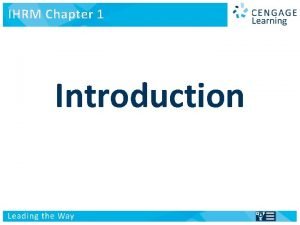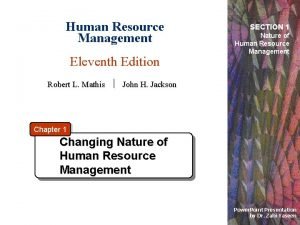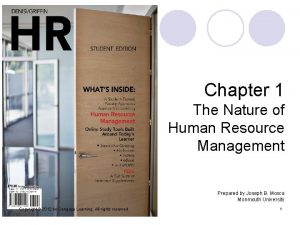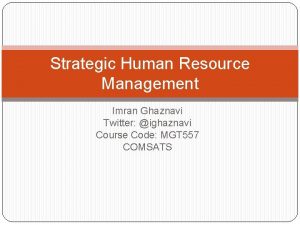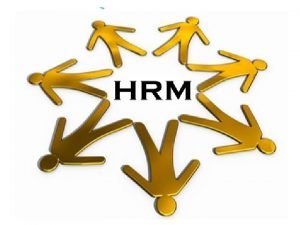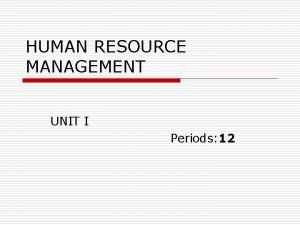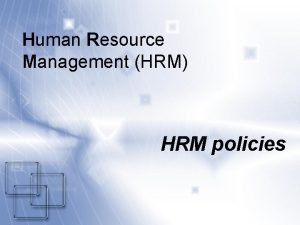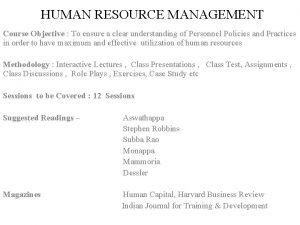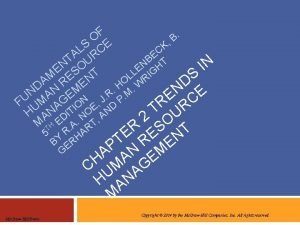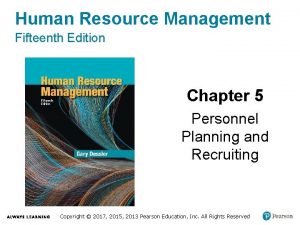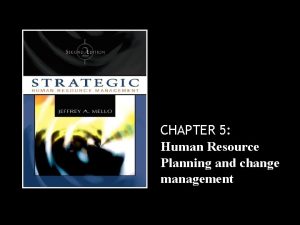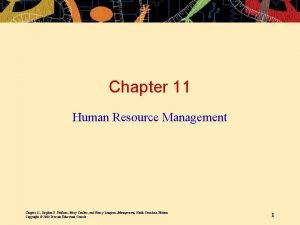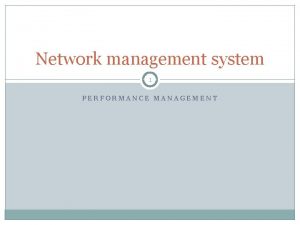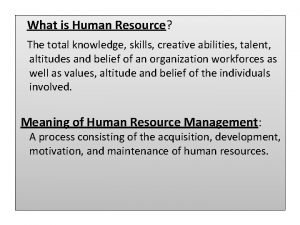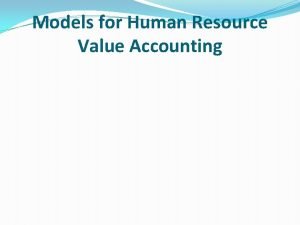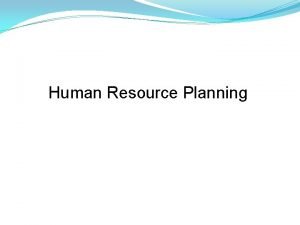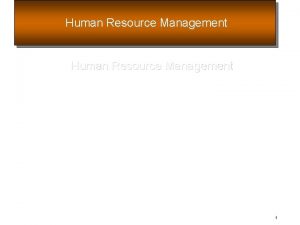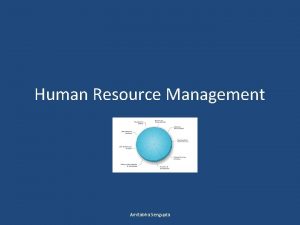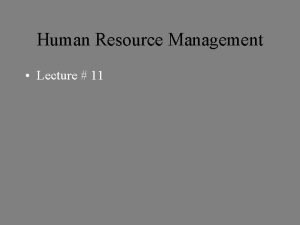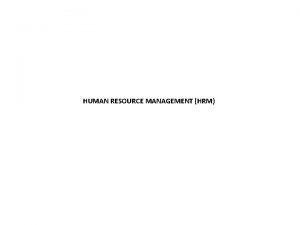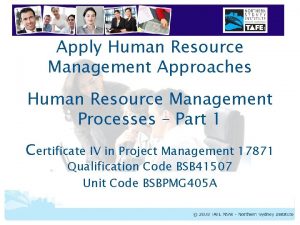Human Resource Management Anu Veerendra Assistant Professor PERFORMANCE










































































































- Slides: 106

Human Resource Management Anu Veerendra Assistant Professor

PERFORMANCE APPRAISAL


Introduction • Essential for the effective management and evaluation of staff. • Appraisals help develop individuals, improve organizational performance, and feed into business planning. • Formal performance appraisals are generally conducted annually for all staff in the organization.

• The history can be dated back to the 20 th century and then to the second world war when the merit rating was used for the first time. • An employer evaluating their employees is a very old concept. • The latest mantra being followed by organizations across the world being – "get paid according to what you contribute”

Meaning Performance Appraisal is the systematic evaluation of the performance of employees and to understand the abilities of a person for further growth and development. Performance appraisal is generally done in systematic ways which are as follows: • The supervisors measure the pay of employees and compare it with targets and plans. • The employers are in position to guide the employees for a better performance.



Objectives of Performance Appraisal can be done with following objectives in mind: 1. To maintain records in order to determine compensation packages, wage structure, salaries raises, etc. 2. To identify the strengths and weaknesses of employees to place right men on right job. 3. To maintain and assess the potential present in a person for further growth and development. 4. To provide a feedback to employees regarding their performance and related status. 5. It serves as a basis for influencing working habits of the employees. 6. To review and retain the promotional and other training programmes.

Need for Performance Appraisal Performance appraisal is needed in order to: • Provide information about the performance ranks based on which decision regarding salary fixation, confirmation, promotion, transfer and demotion are taken. • Provide feedback information about the level of achievement and behavior of subordinate. This information helps to review the performance of the subordinate, rectifying performance deficiencies and to set new standards of work, if necessary. • Provide information which helps to counsel the subordinate. • Provide information to diagnose deficiency in employee regarding skill, knowledge, determine training and development needs and to prescribe the means for employee growth provides information for correcting placement. • To prevent grievances and in disciplinary activities.

Purpose of performance appraisal Administrative purposes: • Document HR decisions with regard to performance and its related issues. • Determine promotion of employees. • Determine transfers and change in job assignments. • Identify poor performance areas of employees. • Decide retention or termination.

• Decide on layoffs. • Validate Selection criteria relating performance scores to selection test and interview scores. • Meet legal requirements. • Evaluate the performance of training programmes • Plan for changes in HR requirements. • Decide on salary and reward issues.

DEVELOPMENT PURPOSES: • Provide performance feedback to all concerned. • Identify individual skills, core competencies, strength and weaknesses. • Recognize individual performance levels. • Assist the employees in setting goals/ identifying goals based on unit level/departmental level and organizational goals. • Evaluate goal achievement of employees. • Identify individual training needs. • Determine organizational training needs • Reinforce authority structure. • Allow employees to discuss concerns. • Improve communication. • Provide a forum for leaders to help the subordinates.

Advantages of Performance Appraisal It is said that performance appraisal is an investment for the company which can be justified by following advantages: • Promotion: Performance Appraisal helps the supervisors to chalk out the promotion programmes for efficient employees. In this regards, inefficient workers can be dismissed or demoted in case. • Compensation: Performance Appraisal helps in chalking out compensation packages for employees. Merit rating is possible through performance appraisal. Performance Appraisal tries to give worth to a performance. Compensation packages which includes bonus, high salary rates, extra benefits, allowances and pre-requisites are dependent on performance appraisal. The criteria should be merit rather than seniority.

• Employees Development: The systematic procedure of performance appraisal helps the supervisors to frame training policies and programmes. It helps to analyse strengths and weaknesses of employees so that new jobs can be designed for efficient employees. It also helps in framing future development programmes. • Selection Validation: Performance Appraisal helps the supervisors to understand the validity and importance of the selection procedure. The supervisors come to know the validity and thereby the strengths and weaknesses of selection procedure. Future changes in selection methods can be made in this regard.

Communication: For an organization, effective communication between employees and employers is very important. Through performance appraisal, communication can be sought for in the following ways: – Through performance appraisal, the employers can understand accept skills of subordinates. – The subordinates can also understand create a trust and confidence in superiors. – It also helps in maintaining cordial and congenial labour management relationship. – It develops the spirit of work and boosts the morale of employees. All the above factors ensure effective communication. • Motivation: Performance appraisal serves as a motivation tool. Through evaluating performance of employees, a person’s efficiency can be determined if the targets are achieved. This very well motivates a person for better job and helps him to improve his performance in the future. •

Disadvantages of Performance Appraisal: • First Impression (primacy effect): Raters form an overall impression about the ratee on the basis of some particular characteristics of the ratee identified by them. The identified qualities and features may not provide adequate base for appraisal. • Halo Effect: The individual’s performance is completely appraised on the basis of a perceived positive quality, feature or trait. In other words this is the tendency to rate a man uniformly high or low in other traits if he is extra-ordinarily high or low in one particular trait. If a worker has few absences, his supervisor might give him a high rating in all other areas of work. • Horn Effect: The individual’s performance is completely appraised on the basis of a negative quality or feature perceived. This results in an overall lower rating than may be warranted. “He is not formally dressed up in the office. He may be casual at work too!”.

• Excessive Stiffness or Lenience: Depending upon the raters own standards, values and physical and mental makeup at the time of appraisal, ratees may be rated very strictly or leniently. Some of the managers are likely to take the line of least resistance and rate people high, whereas others, by nature, believe in the tyranny of exact assessment, considering more particularly the drawbacks of the individual and thus making the assessment excessively severe. The leniency error can render a system ineffective. If everyone is to be rated high, the system has not done anything to differentiate among the employees. • Central Tendency: Appraisers rate all employees as average performers. That is, it is an attitude to rate people as neither high nor low and follow the middle path. For example, a professor, with a view to play it safe, might give a class grade near the equal to B, regardless of the differences in individual performances. • Personal Biases: The way a supervisor feels about each of the individuals working under him - whether he likes or dislikes them as a tremendous effect on the rating of their performances. Personal Bias can stem from various sources as a result of information obtained from colleagues, considerations of faith and thinking, social and family background and so on.

• Spillover Effect: The present performance is evaluated much on the basis of past performance. “The person who was a good performer in distant past is assured to be okay at present also”. • Recency. Rating only recent performance, good or bad. Data should be representative of the entire review period. If you’re not keeping good notes, you may not remember the whole period. Armstrong noted that "you want to make sure, again, that you’re keeping records so that you can adequately describe performance over an entire performance period. " • The sunflower effect. Rating everyone high, regardless of performance, to make yourself look good or to be able to give more compensation.

WHO WILL APPRAISE?

Supervisors • Supervisors include superiors of the employee, other superiors • • having knowledge about the work of the employee and departmental head or manager. The general practice is that immediate superiors appraise the performance, which in turn, is reviewed by the departmental head/manager. This is because supervisors are responsible for managing their subordinates and they have the opportunity to observe, direct and control the subordinates continuously. Moreover, they are accountable for the successful performance of their subordinates. Sometimes other supervisors, who have close contact with employee work also appraise with a view to provide additional information.


• On the negative side, immediate supervisors may emphasize certain aspects of employee performance to the neglect of others. • Also, managers have been known to manipulate evaluations to justify their decisions on pay increases and promotions. • However, the immediate supervisor will continue to evaluate employee performance till a better alternative is available. • Organizations, no doubt, will seek alternatives because of the weaknesses mentioned above and a desire to broaden the perspective of the appraisal.

Peers • Peer appraisal may be reliable if the work group is stable over a reasonably long period of time and performs tasks that require interaction. • However, little research has been conducted to determine how peers establish standards for evaluating others or the overall effect of peer appraisal on the group's attitude. • Whatever research was done on this topic was mostly done on military personnel at the management or premanagement level (officers or officer candidates) rather than on employees in business organizations. • More often than not in business organizations if employees were to be evaluated by their peers, the whole exercise may degenerate into a popularity contest, paving the way for the impairment of work relationships.


Subordinates • The concept of having superiors rated by subordinates is being used in most organizations today, especially in developed countries. • For instance in most US universities students evaluate a professor's performance in the classroom. • Such a novel method can be useful in other organizational settings too provided the relationships between superiors and subordinates are cordial. • Subordinates' ratings in such cases can be quite useful in identifying competent superiors. The rating of leaders by combat soldiers is an example. • However, the fear of reprisal often compels a subordinate to be dishonest in his ratings. Though useful in universities and research institutions, this approach may not gain acceptance in traditional organizations where subordinates practically do not enjoy much discretion.


Self-appraisal • If individuals understand the objectives they are expected to achieve and the standards by which they are to be evaluated, they are to a great extent, in the best position to appraise their own performance. • Also, since employee development means selfdevelopment, employees who appraise their own performance may become highly motivated.


Users of services • Employees' performance in service organizations relating to behaviors, promptness, speed in doing the job and accuracy can be better judged by the customers or users of services. • For example, a teacher's performance is better judged by students and the performance of a conductor a bus is better judged by passengers.

Consultants • Sometimes consultants may be engaged for appraisal when employees or employers do not trust the supervisory appraisal and management does not trust the self-appraisal or peer appraisal or subordinate appraisal. • In this situation, consultants are trained and they observe the employee at work for sufficiently long periods for the purpose of appraisal. • In view of the limitations associated with each and every method discussed above, several organizations follow a multiple rating system wherein several superiors separately fill out rating forms on the same subordinate. The results are then tabulated.


360 degree performance appraisal Definition • In the formatted from of 360 -degree performance appraisals, the performance of an employee will be assessed based on ideas of many other different people, for example customers, suppliers, peers and direct reports. • If the assessed is a manager, his/her staff will be often asked for feedback on how that manager is doing his task. • In case of using 360 -degree performance appraisal, it is vital that the process be implemented by the manager of Human Resources Department so that the subordinate reviewers (or staff) are made sure that all their assessments on performance are kept anonymous.



Who should conduct 360 degree performance appraisal? • Subordinates. • Peers. • Managers (i. e. superior). • Team members. • Customers. • Suppliers/ vendors. • Anyone who comes into contact with the employee and can provide valuable insights and information.

What’s 360 degree measures? • 360 degree measures manners and capacities. • 360 degree improves such skills as listening, planning and goal-setting. • 360 degree concentrates on subjective areas, for example efficiencies of teamwork, character, and leadership. • 360 degree supplies on the way others think about a specific staff.

Advantages of 360 degree appraisal • Offer a more comprehensive view towards the performance of employees. • Improve credibility of performance appraisal. • Such colleague’s feedback will help strengthen self-development. • Increases responsibilities of employees to their customers. • The mix of ideas can give a more accurate assessment. • Opinions gathered from lots of staff are sure to be more persuasive. • Not only manager should make assessments on its staff performance but other colleagues should do, too. • People who undervalue themselves are often motivated by feedback from others. • If more staff takes part in the process of performance appraisal, the organizational culture of the company will become more honest.

Disadvantages of 360 degree appraisal • Taking a lot of time, and being complex in administration • Extension of exchange feedback can cause troubles and tensions to several staff. • There is requirement for training and important effort in order to achieve efficient working. • It will be very hard to figure out the results. • Feedback can be useless if it is not carefully and smoothly dealt. • Can impose an environment of suspicion if the information is not openly and honestly managed.

Are performance appraisals truly beneficial? Think about everything that performance appraisals can achieve and contribute to when they are properly managed, for example: • performance measurement - transparent, short, medium and long term • clarifying, defining, redefining priorities and objectives • motivation through agreeing helpful aims and targets • motivation though achievement and feedback • training needs and learning desires - assessment and agreement • identification of personal strengths and direction - including unused hidden strengths.

• career and succession planning - personal and organisational • team roles clarification and team building • organisational training needs assessment and analysis • appraisee and manager mutual awareness, understanding and relationship • resolving confusions and misunderstandings • reinforcing and cascading organizational philosophies, values, aims, strategies, priorities, etc

• delegation, additional responsibilities, employee growth and development • counseling and feedback • manager development - all good managers should be able to conduct appraisals well - it's a fundamental process • the list goes on. .

Types of performance and Aptitude assessments, including formal Performance Appraisals • • • Formal annual performance appraisals Probationary reviews Informal one-to-one review discussions Counseling meetings Observation on the job Skill- or job-related tests

• Assignment or task followed by review, including secondments (temporary job cover or transfer) • Assessment centers, including observed group exercises, tests presentations, etc. • Survey of opinion of others who have dealings with the individual • Psychometric tests and other behavioral assessments • Graphology (handwriting analysis)

Holding regular informal one-to-one review meetings greatly reduces the pressure and time required for the annual formal appraisal meeting. Holding informal reviews every month is ideal all staff. There are several benefits of reviewing frequently and informally: • The manager is better informed and more upto-date with his or her people's activities (and more in touch with what lies beyond, e. g. , customers, suppliers, competitors, markets, etc).

• Difficult issues can be identified, discussed and resolved quickly, before they become more serious. • Help can be given more readily - people rarely ask unless they see a good opportunity to do so - the regular informal review provides just this. • Assignments, tasks and objectives can be agreed completed and reviewed quickly leaving actions more than a few weeks reduces completion rates significantly for all but the most senior and experienced people.

• Objectives, direction, and purpose is more up-todate - modern organizations demand more flexibility than a single annual review allows priorities often change through the year, so people need to be re-directed and re-focused. • Training and development actions can be broken down into smaller more digestible chunks, increasing success rates and motivational effect as a result. • The 'fear factor', often associated by many with formal appraisals, is greatly reduced because people become more comfortable with the review process.

• Relationships and mutual understanding develops more quickly with greater frequency of meetings between manager and staff member. • Staff members can be better prepared for the formal appraisal, giving better results, and saving management time. • Much of the review has already been covered throughout the year by the time comes for the formal appraisal. • Frequent review meetings increase the reliability of notes and performance data, and reduces the chances of overlooking things at the formal appraisal.

• Training isn't restricted to sending someone on an external course - it includes internal courses, coaching, mentoring (mentoring someone else and well as being mentored), secondment to another role (e. g. deputizing for someone while they are away on holiday), shadowing, distancelearning, reading books, watching videos, attending meetings and workshops, workbooks, manuals and guides, researching, giving presentations; anything relevant and helpful that will help the person develop towards the standard and agreed task. • Be careful to avoid committing to training expenditure before suitable approval, permission or availability has been confirmed - if necessary discuss likely training requirements with the relevant authority before the appraisal to check. • Raising false hopes is not helpful to the process.


Methods of performance Three types of Methods: 1. Trait methods 2. Behavioral Methods 3. Results Methods

1. Trait Methods 1. 2. 3. 4. 5. Graphic Rating Scales Ranking Methods Paired Comparison Method Forced Distribution Method Checklist Method a) Simple Checklist b) Weighted Checklist c) Forced Choice Method 6. Essay/Free Form Appraisal 7. Confidential Reports.

Graphic Rating Scales • Graphic rating scale method is one of the oldest and widely used method. • Also Known as Linear rating scale or simple rating scale. • Graphic rating scale method is easy to understand simple to use. • It also consumes less time. • However, it involves a lot of paper work and there are chances of bias by the rater.



Advantages : -- • Graphic rating scales are less time consuming to develop. • They also allow for quantitative comparison. Disadvantages : - • Different supervisors will use the same graphic scales in slightly different ways. • One way to get around the ambiguity inherent in graphic rating scales is to use behavior based scales, in which specific work related behaviors are assessed. • More validity comparing workers ratings from a single supervisor than comparing two workers who were rated by different supervisors.

Ranking Methods • All the employees who are doing the same job are compared with each other. • Then, each employee is given a particular rank, i. e. First Rank, Second Rank, etc. • The best employee is given the first rank, and the worst employee is given the last rank.


Paired Comparison Method • This form of performance appraisal is a good way to make full use of the methods of options. • There will be a list of relevant options. • Each option is in comparison with the others in the list. • The results will be calculated and then such option with highest score will be mostly chosen.


• Advantages: - • It helps you to set priorities where there are conflicting demands on your resources. • This makes it easy to choose the most important problem to solve, or select the solution that will give you the greatest advantage. • Disadvantages : - • It is useful where priorities are not clear. • It is particularly useful where you do not have objective data to base this on.

Forced Distribution Method • Forced distribution is a form of comparative evaluation in which an evaluator rates subordinates according to a specified distribution. • Use of the forced distribution method is demonstrated by a manager who is told that he or she must rate subordinates according to the following distribution:


Advantages: - • They force reluctant managers to make difficult decisions and identify the most and least talented members of the work group. • They create and sustain a high performance culture in which the workforce continuously improves. • Disadvantages: - • They increase unhealthy cut-throat competitiveness; • They discourage collaboration and teamwork; • They harm morale; • They are legally suspect giving rise to age discrimination cases.

Checklist Method • It’s a simple rating technique in which the supervisor is given a list of statements or words and asked to check statements representing the characteristics and performance of each employee. • 3 types of Checklist methods: 1. Simple Checklist


Weighted Checklist • In this style, performance appraisal is made under a method where the jobs being evaluated based on descriptive statements about effective and ineffective behavior on jobs.


• Advantages : - • This method help the manager in evaluation of the performance of the employee. • The rater may be biased in distinguishing the positive and negative questions. He may assign biased weights to the questions. • Disadvantages : - • This method also is expensive and time consuming. • It becomes difficult for the manager to assemble, analyze and weigh a number of statements about the employee’s characteristics, contributions and behaviors.

Forced Choice Method • Here only one statement is selected by appraiser that describes employee’s behavior. Example: • Yes • no

Essay/Free Form Appraisal • Essay is the simplest method of rating an employee. • Rater writes in detail, the employee's strengths, weaknesses and potential. He also gives suggestions for improvement. • If the essays are written well then they can be used to improve the performance of the employees. • This method is better than other complex methods.


• Advantages : - • The essay method is far less structured and confining than the rating scale method. It permits the appraiser to examine almost any relevant issue or attribute of performance. This contrasts sharply with methods where the appraisal criteria are rigidly defined. • Appraisers may place whatever degree of emphasis on issues or attributes that they feel appropriate. Thus the process is open-ended and very flexible. The appraiser is not locked into an appraisal system the limits expression or assumes that employee traits can be neatly dissected and scaled.

• Disadvantages : - • Essay methods are time-consuming and difficult to administer. Appraisers often find the essay technique more demanding than methods such as rating scales. • The techniques greatest advantage - freedom of expression - is also its greatest handicap. The varying writing skills of appraisers can upset and distort the whole process. • The process is subjective and, in consequence, it is difficult to compare and contrast the results of individuals or to draw any broad conclusions about organizational needs. • Manager / supervisor may write a biased essay. • A busy rater may write the essay hurriedly without properly assessing the actual performance of the worker. • Apart from that, rater takes a long time, this becomes uneconomical from the view point of the firm, because the time of rater is costly. • Some evaluators may be poor in writing essays on employee performance. Others may be superficial in explanation and use flowery language which may not reflect the actual performance of the employee.

Confidential Reports • It is prepared by his immediate superior. • It contains information about the employee's strengths, weaknesses, major failure and achievements. • It also contains information about the employee's personality traits (qualities) and about his behavior. • Confidential report is used to take decisions about transfers, promotions, etc.


2. Behavioral Methods 1. 2. 3. 4. 5. 6. Behavioral checklist Method Critical Incident Method Behaviorally Anchored Rating Scales Behavioral Observations Scales Assessment Center Psychological Appraisal

Behavioral checklist Method • A checklist is designed with the list of statements that describe the behavior essential for employee performance. • The appraiser checks whether the appraisee possesses them or not. • Employee performance is rated based on the behavioral skills that the employee possesses to the total statements.

Critical Incident Method • supervisor writes a brief report about any incident, which affects the performance of the job. • The incident may be positive or negative. For e. g. A salesman is very patient with a difficult customer, and he succeeds in selling the goods to that customer. This is a critical incident. • The supervisor writes a brief report about this incident. This report is in favor of the salesman. • So the salesmen will get a high rating. • This method has some disadvantages, as some supervisors only record negative incidents. They do not record positive incidents. Some supervisors are also biased while recording the incidents.

• ADVANTAGES: - • Critical incident is a method used for many sectors. Each employee will be evaluated as such and one’s performance appraisal will be based on the logs that are put in the evaluation form. • The manager maintains logs on each employee, whereby he periodically records critical incidents of the workers behavior. • At the end of the rating period, these recorded critical incidents are used in the evaluation of the workers’ performance. • The critical incidents file of performance appraisal is a form of documentation that reflect all data about employee performances.

Disadvantages: -This method suffers however from the following limitations: • Critical incidents technique of evaluation is applied to evaluate the performance of superiors rather than of peers of subordinates. • Negative incidents may be more noticeable than positive incidents. • It results in very close supervision which may not be liked by the employee. • The recording of incidents may be a chore for the manager concerned, who may be too busy or forget to do it. • The supervisors have a tendency to unload a series of complaints about incidents during an annual performance review session.

Behaviorally Anchored Rating Scales • Behaviorally Anchored Rating Scales (BARS) is a relatively new technique which combines the graphic rating scale and critical incidents method. • It consists of predetermined critical areas of job performance or sets of behavioral statements describing important job performance qualities as good or bad (for eg. the qualities like inter-personal relationships, adaptability and reliability, job knowledge etc). These statements are developed from critical incidents. In this method, an employee’s actual job behavior is judged against the desired behavior by recording and comparing the behavior with BARS. Developing and practicing BARS requires expert knowledge.

Advantages & Disadvantages : - • This method are very useful and exactly. • It is very difficult to develop this method because you need to identify what is “good level” etc.

Behavioral Observations Scales(BOS) • Behavioral observation is a method used to measure the behavior and value of employees whose job performance cannot be evaluated on the basis of productivity alone. • Such measurements are usually made based on a behavioral observation scale that is used to evaluate everyone in a comparable manner. • Such scales are generally used to record whether or not an employee engages in a certain type of behavior or action and, if so, how often. • Each employee's result from the behavioral observation scale can be compared to other employees' results or to some objective baseline for expected behavior. • Evaluation of this sort can be used to ensure that an employee is meeting expectation or to determine if disciplinary action is necessary.

Assessment Center • An assessment centre typically involves the use of methods like social/informal events, tests and exercises, assignments being given to a group of employees to assess their competencies to take higher responsibilities in the future. • Generally, employees are given an assignment similar to the job they would be expected to perform if promoted. • The trained evaluators observe and evaluate employees as they perform the assigned jobs and are evaluated on job related characteristics. • The major competencies that are judged in assessment centers are interpersonal skills, intellectual capability, planning and organizing capabilities, motivation, career orientation etc. assessment centers are also an effective way to determine the training and development needs of the targeted employees.

Psychological Appraisal • These appraisals are more directed to assess employees potential for future performance rather than the past one. • It is done in the form of in-depth interviews, psychological tests, and discussion with supervisors and review of other evaluations. • It is more focused on employees emotional, intellectual, and motivational and other personal characteristics affecting his performance. • This approach is slow and costly and may be useful for bright young members who may have considerable potential. • However quality of these appraisals largely depend upon the skills of psychologists who perform the evaluation.

3. Results Methods 1. 2. 3. 4. Productivity Measures Balanced Scorecard Human Resource Accounting Management by Objectives.

Productivity Measures • Employees are praised based on the ratio of output they turned out to the input they used. • The measure of productivity is defined as a total output per one unit of a total input • For ex. Salary and benefits calculated on number of employees served per day.

Balanced Scorecard • "The balanced scorecard retains traditional financial measures. • But financial measures tell the story of past events, an adequate story for industrial age companies for which investments in long-term capabilities and customer relationships were not critical for success. • These financial measures are inadequate, however, for guiding and evaluating the journey that information age companies must make to create future value through investment in customers, suppliers, employees, processes, technology, and innovation. " •

The two basic features of the balanced scorecard are: - A balanced set of measures based on the four perspectives of balanced scorecard -Linking the measures to Employee Performance

Human Resource Accounting • Human Resource Accounting HRA measures the cost and contribution of human resources in the organization. • The cost includes the cost of recruitment, selection, induction, training, salaries and other facilities, etc. • Contribution is the money value of the service of the employees. • This service is measured by labour productivity. If the contribution is more than the cost, then the employee performance is positive and vice-versa.

Management by Objectives • The process of setting objectives in the organization to give a sense of direction to the employees. • It refers to the process of setting goals for the employees so that they know what they are supposed to do at the workplace. • The Management by Objectives process helps the employees to understand their duties at the workplace. • Management by Objectives ensures effective communication amongst the employees. It leads to a positive ambience at the workplace.

Advantages : -- • It is based on the assumption that the individual (employee) knows more than anyone else about her/his own capabilities, needs, strengths, weaknesses and goals. • A further advantage of MBO is that the emphasis is on the future rather than on the past. Appraisal thus becomes a means to a constructive end. • MBO is often achieved using set targets. MBO introduced the SMART criteria: Objectives for MBO must be SMART (Specific, Measurable, Achievable, Relevant, and Time. Specific). • Several managers have employed this management technique and have applied it to their company. These managers include Mukesh Ambani, Don Sheelen and Steve Jobs.

Disadvantages: -1. Positive and active participation from subordinates is not easily forthcoming. 2. Truly verifiable goals are both easy to formalize 3. Emphasis is put in short-range goals, whereas long-range goals are avoided, tough long-range goals are vital for growth and development of the organization 4. Goals remain inflexible and rigid. For example, changes desirable in annual budgets are not easily accepted in the middle of the year. 5. Over-use of quantitative goals jeopardizes the qualitative aspect which may more important than quantification in some cases.

System of Performance Appraisal • Establish performance Standards • Communicate Standards/ expectations to employees • Measure actual performance by following the instructions. • Adjust the actual performance due to the environmental influence. • Compare adjusted performance with that of others and previous

• Compare the actual performance with standards and find out deviations, if any. • Communicate the actual performance to the employee concerned • Suggest changes in job analysis and standards, if necessary • Follow up performance appraisal report.

counseling • When you need to take action over employees’ unsatisfactory work performance or conduct, but dismissal is not justified, the options include counseling, discipline, warnings, and possibly suspension and fines or withholding pay. • It is important to choose the action that is appropriate to the circumstances of each case, as the aim should be a positive one — that is to improve performance or prevent a recurrence of unsatisfactory conduct, rather than to administer 'punishment'.

COUNSELING is a formal process, initiated when a person has not responded to advice and assistance you have provided on a less formal basis, and will usually involve your taking the following steps: • Advise the person in advance that a discussion about his or her work performance or conduct is to be held at a given time and place, with sufficient notice to enable you both to come to the discussion prepared; • Arrange for the meeting to be held in private, although a support person for the person being counseled may be present, as well as someone you may have asked to attend as an observer; and • Keep a brief record of the meeting—this could be a diary note.

When to counsel? Performance counseling is best suited to situations where a problem is ongoing, where it is a one-off instance and the consequences are unlikely to be serious (see below), and where one of the following applies: • It affects the employee’s productivity — such as excessive absenteeism, lateness or work breaks, poor work planning or time management, poor work quality, etc. • It affects other employees’ productivity — for example, they have to do extra checks or correct mistakes, or it adds to their workload in other ways. Another cause is when they are continually interrupted, e. g. by non-work emails, socializing, noise level, etc. • It breaches policies/procedures — for example, occupational health and safety, timekeeping, dress codes. If breaches appear to be condoned, other employees may perceive that it is OK to behave in similar fashion. Counseling is not usually appropriate where the actual or potential consequences are serious, such as a threat to safety or health, major cost or damage, or a threat to the employer’s viability or reputation.

What counseling involves? • Involves discussion with the employee that sets out and reinforces what is required of him/her, but which also probes for causes of the problem and identifies possible remedial action (such as retraining, referral to an Employee Assistance Program, extra assistance with the job or other changes to it). • Point out the adverse effects of the current performance/conduct on other individual employees and the work group, as well as the implications it may have for the employee’s future career prospects and possibly job security.

• The discussion should cover precisely what the employee is doing/has done wrong, as well as its impact. • Provide specific examples of both, supported by objective and documented evidence. • Explore reasons why the problems are occurring. • Don’t go into a performance counselling session with a predetermined diagnosis and remedy. Decide what to do after you have explored the options.

who should give the counseling? • In most cases it is responsibility of manager to provide counseling to staff in relation to work performance and conduct. • However, in circumstances where performance is affected by factors outside the workplace, • for example if a person has a problem with drugs or alcohol or has difficulties in their private life, it may be appropriate, after an initial discussion, to refer the person to a staff counselor or counselor from an Employee Assistance Program (EAP).

who should be present? • A counseling discussion usually involves a manager or supervisor and a staff member but, in some situations, you may find that a person requests the presence of a support person or independent observer. • A person or persons attending a session in this capacity would not normally take part in the discussion and their presence and role should be clarified before the session commences.

where should you counsel ? • Generally, people should be praised in public and criticized in private. • It is advisable first to let a person know they have done a good job. • Your office, if you have one, may be appropriate but, in some situations, a more neutral meeting place away from the immediate work area may be preferable. • Where possible, a suitable time for the discussion should be agreed in advance and sufficient notice given to allow both yourself and the staff member to prepare adequately.

Managerial appraisal • • • Harold Koontz has developed a concept of managerial appraisal i. e. , appraising managers. According to this concept the managers attain the organizational objectives by performing the basic managerial functions, viz. , Planning, Organizing, Leading, Motivating, Staffing and controlling. Each of these functions can be performed by performing a number of or series of activities.

• For example, performing staffing function requires performing a series of activities like -Analyzing jobs of his department, -Planning for human resources, -Deciding upon internal and external recruitment, - Developing sources and recruitment techniques. • Thus, each function and sub-function of manager is elaborated into a series of activities. • These activities, in this model are taken as behavior and standards of performance. • The checklist containing the questions in these areas is prepared with a five degree rating scale, i. e. , extremely poor performance, neither poor nor fair performance and extremely fair performance.
 Performance appraisal in human resource management
Performance appraisal in human resource management Management fifteenth edition
Management fifteenth edition Raguman nyaeta
Raguman nyaeta Z transform time reversal
Z transform time reversal Time management in human resource management
Time management in human resource management Retail store organizational structure
Retail store organizational structure Literal sense in hrm
Literal sense in hrm Promotion from associate professor to professor
Promotion from associate professor to professor Fok ping kwan
Fok ping kwan Project human resource management pmbok ppt
Project human resource management pmbok ppt Human resource management pmbok
Human resource management pmbok Important of human resources management
Important of human resources management Human resource management in restaurants
Human resource management in restaurants Induction definition in hrm
Induction definition in hrm Human resource management chapter 2
Human resource management chapter 2 Chapter 9 human resources management
Chapter 9 human resources management Human resource management system project ppt
Human resource management system project ppt Current issues in human resource management
Current issues in human resource management Ba human resource management
Ba human resource management Higher business management
Higher business management Human resources management gaining a competitive advantage
Human resources management gaining a competitive advantage Human resource management gaining a competitive advantage
Human resource management gaining a competitive advantage Human resource management gaining a competitive advantage
Human resource management gaining a competitive advantage Human resource management final exam essay questions
Human resource management final exam essay questions Human resource management 15th edition
Human resource management 15th edition Gary dessler human resource management
Gary dessler human resource management Strategic human resource
Strategic human resource Investment perspective of human resource management
Investment perspective of human resource management Chapter 11 human resource management
Chapter 11 human resource management New approaches to organizing hr
New approaches to organizing hr Human resource management chapter 1
Human resource management chapter 1 Applied psychology in human resource management
Applied psychology in human resource management Nature of hrm
Nature of hrm Unit 3 human resource management
Unit 3 human resource management Seperation in hrm
Seperation in hrm Human resources and job design in operations management
Human resources and job design in operations management Definition of human resource management
Definition of human resource management Weiterbildung human resources management
Weiterbildung human resources management Human resource management syllabus harvard
Human resource management syllabus harvard Hrm course syllabus
Hrm course syllabus Human resource management information system (hrmis)
Human resource management information system (hrmis) Human resource management defintion
Human resource management defintion Introduction of hrm
Introduction of hrm Human resource management laura portolese
Human resource management laura portolese Wbs human resource management
Wbs human resource management Toyota hrm practices
Toyota hrm practices International human resource management dowling 6th edition
International human resource management dowling 6th edition Factors influencing human resource management
Factors influencing human resource management Investment perspective of hr
Investment perspective of hr Applied psychology in human resource management
Applied psychology in human resource management Applied psychology in human resource management
Applied psychology in human resource management Payroll cycle activities
Payroll cycle activities Retrenchment strategy meaning
Retrenchment strategy meaning Human resource management lecture chapter 1
Human resource management lecture chapter 1 Human resource management skills
Human resource management skills Costco tw
Costco tw Teletraining in hrm
Teletraining in hrm Virtual assignment in ihrm
Virtual assignment in ihrm Selection in human resource management
Selection in human resource management Mgt 501
Mgt 501 Human resource management chapter 4
Human resource management chapter 4 Functions of hrm
Functions of hrm Interview in human resource management
Interview in human resource management System defintion
System defintion Social factors affecting human resource management
Social factors affecting human resource management Chapter 7 human resource management
Chapter 7 human resource management Chapter 7 human resource management
Chapter 7 human resource management Scatter plot in hrm
Scatter plot in hrm Human resource management chapter 4
Human resource management chapter 4 Polycentric hr
Polycentric hr Cascade approach in human resource management
Cascade approach in human resource management Applied psychology in human resource management
Applied psychology in human resource management Human resource management tools and techniques
Human resource management tools and techniques Project management human resources
Project management human resources Difference between domestic hrm and ihrm
Difference between domestic hrm and ihrm Global trends in hrm
Global trends in hrm Human resource management gaining a competitive advantage
Human resource management gaining a competitive advantage Hrm nature
Hrm nature Nature of hrm
Nature of hrm Human resource management: gaining a competitive advantage
Human resource management: gaining a competitive advantage Unit 16 human resource management
Unit 16 human resource management Concepts of hrm
Concepts of hrm Nature of hrm
Nature of hrm Objectives of hrm
Objectives of hrm Human resource policy
Human resource policy Human resource management course objectives
Human resource management course objectives International resource services
International resource services Nature of human resource management
Nature of human resource management Project management chapter 4
Project management chapter 4 Human resource management gaining a competitive advantage
Human resource management gaining a competitive advantage Replacement chart
Replacement chart Human resource management
Human resource management Human resource management chapter 5
Human resource management chapter 5 Chapter 11 human resource management
Chapter 11 human resource management Behaviorally anchored rating scales
Behaviorally anchored rating scales Performance levels
Performance levels Resource leveling is the approach to even out the peaks of
Resource leveling is the approach to even out the peaks of Perbedaan antara resource loading dan resource levelling
Perbedaan antara resource loading dan resource levelling Office management assistant psc
Office management assistant psc Network performance management functions
Network performance management functions Morse net benefit model
Morse net benefit model Managerial judgement technique in hrm example
Managerial judgement technique in hrm example Human resource development framework
Human resource development framework Aboriginal human resource council
Aboriginal human resource council Hermansons model
Hermansons model Long term hr planning
Long term hr planning Human resource planning
Human resource planning
